How to Break New Car Engine
Introduction
Breaking in a new car engine is a crucial process that helps ensure its longevity and performance. Proper break-in procedures allow the engine’s components to gradually adjust to each other, resulting in smoother operation and reduced wear. This guide will provide comprehensive instructions on how to break in a new car engine effectively.
Break-In Period
The break-in period typically lasts for the first 500 to 1,000 miles (800 to 1,600 kilometers). During this time, it is essential to avoid putting excessive stress on the engine and follow the manufacturer’s recommended break-in procedures.
Driving Techniques
Vary Engine Speed
Continuously varying the engine speed prevents excessive wear on specific engine components. Avoid prolonged periods of driving at a single speed. Vary the speed within the manufacturer’s recommended break-in range.
Avoid High RPMs
Excessive RPMs can put excessive stress on the engine, especially during break-in. Keep the engine RPMs below the manufacturer’s recommended range for the first 500 miles (800 kilometers).
Use Light Acceleration
Avoid sudden or hard acceleration. Gradually accelerate to higher speeds to allow the engine components to adjust smoothly.
Engine Braking
Engine braking, or downshifting to slow down, is acceptable during break-in. However, avoid excessive engine braking or excessive RPMs while engine braking.
Maintenance Considerations
Oil Changes
Regular oil changes are crucial during break-in. The initial oil change should be performed earlier than the manufacturer’s recommended interval, typically around 500 miles (800 kilometers). This removes any debris or metal shavings that may have accumulated during the break-in process.
Coolant Levels
Monitor the coolant levels and top up the reservoir as necessary. Ensure the coolant meets the manufacturer’s specifications.
Other Maintenance Checks
Follow the manufacturer’s maintenance schedule and perform any necessary inspections, such as:
- Air filter inspection
- Tire pressure checks
- Fluid level checks (e.g., transmission fluid, brake fluid)
After Break-In
Once the break-in period is complete, the engine should be fully adjusted and ready for higher performance. However, a gradual transition into higher RPMs and increased performance is recommended. Avoid prolonged periods of excessive speed or stress on the engine.
Conclusion
Breaking in a new car engine is an essential process for maximizing its lifespan and performance. By following the guidelines outlined in this guide, including varying engine speed, avoiding high RPMs, using light acceleration, performing regular maintenance, and gradually transitioning into higher performance, you can ensure a smoother and more reliable driving experience for your new vehicle.





